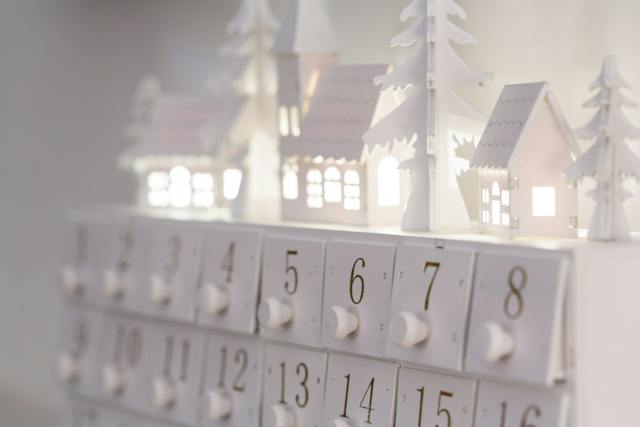An Advent calendar is a special calendar used to count the days of Advent in anticipation of Christmas. Since the date of the First Sunday of Advent varies, falling between November 27 and December 3 inclusive, many Advent calendars begin on December 1, though those that are produced for a specific year often include the last few days of November that are part of the liturgical season. The calendar dates back to the 19th century when German Protestants made chalk marks on doors or lit candles to count the days leading up to Christmas.
Advent calendars come in a variety of forms, but the basic concept remains the same. They typically consist of 24 “doors” or “windows,” each of which is opened to reveal a picture, a small gift, or a piece of chocolate. Some modern Advent calendars contain a Bible verse or a religious image behind each window, reflecting the original Christian tradition. Others have a more secular approach, featuring holiday-themed pictures or treats.
The main purpose of an Advent calendar is to build anticipation for the Christmas holiday, especially for children. It also serves as a way to count down the days in a fun and interactive way. The tradition of the Advent calendar has spread throughout the Christian world and has also become popular in non-religious contexts, often as a form of festive seasonal decoration.
Table of Contents
An advent calendar for 2024
Creating a customized Advent calendar for 2024 would be a delightful project! Here’s an idea for a 24-day Advent calendar, beginning on December 1 and leading up to Christmas Eve:
December 1: A small, festive ornament.
December 2: A handwritten note with a positive affirmation or quote.
December 3: A sachet of hot cocoa mix.
December 4: A puzzle piece (complete a puzzle by Christmas).
December 5: A recipe for a holiday treat.
December 6: A festive sticker or temporary tattoo.
December 7: A holiday-themed bookmark.
December 8: A tea light candle.
December 9: A mini holiday-themed puzzle.
December 10: A packet of seeds for a winter plant.
December 11: A miniature snow globe.
December 12: A DIY ornament kit.
December 13: A small bag of scented potpourri.
December 14: A holiday-themed cookie cutter.
December 15: A pair of festive socks.
December 16: A keychain with a holiday motif.
December 17: A Christmas carol music box.
December 18: A packet of reindeer food (oats and glitter).
December 19: A holiday-themed face mask.
December 20: A set of colored pencils or markers.
December 21: A small jigsaw puzzle.
December 22: A festive mug.
December 23: A DIY hot chocolate bomb kit.
December 24 (Christmas Eve): A personalized letter from Santa or a holiday storybook.
Each item is intended to add a bit of holiday cheer and anticipation as you count down to Christmas. You can customize or alter these suggestions based on personal preferences or traditions!

Conclusion
The Advent calendar is a charming and meaningful tradition that spans both religious and secular realms. Originating in 19th-century Germany, it has since evolved into a beloved global custom that heralds the festive season. Its primary purpose is to create a sense of anticipation and joy as Christmas approaches, offering a daily surprise or reflection in the form of images, small gifts, or treats behind each of its 24 doors. Whether rooted in Christian faith or embraced for its holiday cheer, the Advent calendar remains a symbol of the countdown to Christmas, fostering a sense of excitement and wonder in both children and adults alike.
Frequently Asked Questions (FAQs) About the Advent calendar
What is an Advent calendar?
An Advent calendar is a special calendar used to count the days in anticipation of Christmas, starting from December 1st and ending on December 24th. It typically features 24 doors or windows, each concealing a picture, a small gift, or a piece of chocolate.
Where did the Advent calendar originate?
The Advent calendar originated in 19th-century Germany. German Protestants would make chalk marks on doors or light candles to count the days leading up to Christmas.
What are the different types of Advent calendars?
Advent calendars can range from traditional paper-based ones with pictures or Bible verses, to more modern varieties containing chocolates, toys, or even beauty products.
Can I make my own Advent calendar?
Yes, DIY Advent calendars are popular. You can create them using various materials and fill them with personalized gifts, notes, or activities.
Are Advent calendars religious?
Advent calendars have Christian origins and can include religious content, but many contemporary versions are secular and focus on the festive aspect of the Christmas season.
When should you start using an Advent calendar?
Advent calendars are traditionally started on December 1st and continue until December 24th.
Can Advent calendars be reused?
Some Advent calendars, especially those made of durable materials like wood, can be reused. Paper or cardboard calendars are usually single-use.
Do all Advent calendars have chocolate?
No, not all Advent calendars contain chocolate. While chocolate calendars are popular, there are many other types, including those with toys, messages, or even beauty products.
Is an Advent calendar suitable for all ages?
Yes, there are Advent calendars designed for all age groups, from children to adults.
Where can I buy an Advent calendar?
Advent calendars are widely available in stores, especially during the holiday season, and can also be purchased online.
Can Advent calendars be personalized?
Yes, many companies offer personalized Advent calendars, and you can also create your own for a more personal touch.
Are there digital Advent calendars?
Yes, there are digital versions available, including apps and online calendars, which can offer a variety of virtual surprises or activities.
